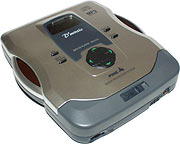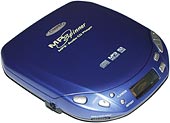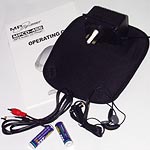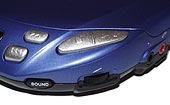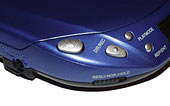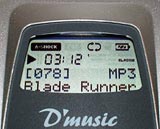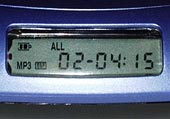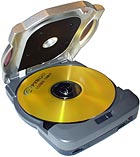
Comparison: Pine Technology D'music SM-200C and Compro MPCD-455 MP3 CD players
Original review date: 12 November 2000.Updated with MPCD-455 info: 7 December 2000.
Last modified 03-Dec-2011.
The Pine Technology D'music SM-200C is a portable CD player. It's more plasticky, and bulkier, than many others. It costs $AU349. $US200, if you're in the States.
It's the grey one.
Compro's MPCD-455 is the same deal; a bit slimmer, and a bit cheaper, at $AU308.
It's the blue one.
Pay $AU350 for a portable CD player from, say, Sony, and you get one that's made out of purest unobtanium and contains a small rapidly rotating degenerate-matter torus that allows it to be slightly smaller than the discs you put in it, and generate more power than it consumes.
So why should you pay this sort of money for plastic CD players from South-East Asia?
'Cos these puppies play MP3s, kids.
The SM-200C was, I think, the first really good MP3 CD player. It can play ordinary audio CDs, but it can also play CDs full of MPEG 1 Layer 3 (to give the format its full name) files. Which means you can have more than ten hours of music on one disc.
The MPCD-455 is the same thing, basically, but has some features the Pine player can't match, which may make it a better buy for many people.
Earlier attempts at this sort of thing weren't exciting. A few short-production-run hacked-together players kinda-sorta hit the market through 2000; the designers just took MP3 decoder hardware, grafted it onto a battery powered CD-ROM drive mechanism, gave it something that'd pass for a user interface in a dim light, and had done with it.
But now we're seeing proper commercial units. Heck, there are ones coming out now that play the popular-in-Asia Video CD format as well, and hook up to your TV!
Neither of these players can do that, and neither of them can play any digital music format other than MP3 - no Windows Media Audio, no Ogg Vorbis. But MP3's the de facto standard, and it's small enough for a given sound quality that 650Mb of it gives you no darn shortage of space at all.
On one CD, just as an example, I put 160 kilobit per second or better versions of the following:
Two versions of Albinoni's Adagio For Organ And Strings, Bach's Suite No.3 In D and Toccata and Fugue in D Minor, two Beethoven piano sonatas and his Symphonies number 2, 5, 6 and 9, Boccherini's Minuet, Mozart's Clarinet Quintet in A, Concertos for Horns numbers 1 and 3, Concerto for Oboe and Orchestra KV 314, Eine Kleine Nachtmusik, Oboe Quartet in F, and his Symphonies number 35, 36, 38 and 40, Pachelbel's Canon, Saint-Saens' Symphony number 3, an Agnus Dei version of Samuel Barber's Adagio for Strings, and Vivaldi's Concerto for Strings and Continuo.
And, still on Vivaldi, the whole Four Seasons.
On one CD.
Most portable MP3 players don't play CDs, of course. They use solid state storage - Flash RAM. This is the same storage most digital cameras use. It doesn't need batteries to maintain its contents, it's shock-proof, and it can be rewritten hundreds of thousands of times.
The various kinds of Flash RAM card - CompactFlash, SmartMedia, MultiMediaCard - all take up very little room, and with no moving parts the players don't need much power, so the manufacturers can make them very teeny and funky-looking indeed. And you don't need anything special to get MP3s into and out of them - the older ones have parallel port interfaces that work with any PC, and newer models are mostly USB, for plug-and-go convenience on PC or Mac.
Unfortunately, flash RAM is really, really expensive.
Want a 64Mb CompactFlash card, for a bit more than an hour of music at 128 kilobit or a bit less than an hour at 160 kilobit? $AU265, thanks. Buy an MP3 player with that much memory built in, and you'll be paying plenty for the RAM that's inside it.
Want more than an hour of music, you greedy thing? $AU390 for a 96Mb card, $AU570 for 128Mb.
If you've already got the cards kicking around, because you've got a digital camera or PDA or some other gizmo that uses them, then OK, fine. A memory card MP3 player's not a totally nutty purchase.
But if you have to buy the cards, and you DO buy the cards, you are a crazy person. Or a very rich person. Or both. You can get a perfectly good belt-clip stereo FM radio for $AU30. Consider it.
The trouble is, if you want your MP3 player to be small and (comparatively) inexpensive and have long battery life, there's no better storage for it to use than flash RAM.
CD transports eat a fair bit of power, and CDs are much larger than memory cards. So portable MP3 CD players get lousy battery life compared with memory card players, and they're much bigger. But at least you get a ton of capacity. And CD blanks cost a buck or two Australian each, tops.
So if you've got a CD writer, or you're willing to buy one, or you know someone who has - then there's a very large and definite attraction to the optical format. Sure, you can't easily shuffle files, but at a buck for 650Mb, who cares?
What you get
The Pine player itself is about 130mm wide by 140mm deep by 30mm tall - on the fat side for current portable audio CD players, but still not particularly chunky. It weighs 280 grams without batteries. The metal-look case is actually all plastic, but solid enough - there's not much flex in the body, and the lid doesn't rattle.
The Compro player is a bit slimmer, at about 130 by 145 by 25mm. It's pretty solid, too, though its lid's a little flimsier.
The SM-200C comes with a software CD, another CD full of sample MP3s, an AC adapter, a couple of rechargeable AA cells, a protective pouch (which provides padding, but doesn't have a belt loop), a set of in-ear headphones, and a 1/8th inch plug to twin RCA plug cable for its line-out connector (so you can connect the player to your home or car stereo).
You get a similar kit with the MPCD-455, but without the software CDs.
On the main Pine software CD, along with the Adobe Acrobat format manual (there's no paper manual), you also get MusicMatch Jukebox v5.1 for Windows. It's a thoroughly capable MP3 recorder and player package with all the usual features and good quality encoding at various bit rates. It's got a non-standard interface that continues the irritating tendency of audio software companies to make programs that look like hi-fi components, but apart from that it's great.
It's not much of a selling point, though; you can download the basic version of Jukebox 6.0 for free. The Pine player comes with an upgrade key to get you the slightly sexier $US20 registered version, but the free version's adequate.
Incidentally, the Compro player's shape is an almost complete rip-off of the styling of Sony's D-E445 Discman. There are, of course, only so many shapes you can make a basic portable CD player, but Compro would appear to have been a bit cheeky, here.
Using them
The SM-200C is quite easy to use, considering that it's a portable stereo with a little teeny display but dozens of tracks to deal with.
Both players have their line-out sockets on the back panel, and both let you use both outputs at once, if you like.
The Pine player has a front-mounted volume control, a four-way playback control button, and only four other buttons - EQ, Repeat, Anti-Shock and Scan. The Play/Pause and Stop parts of the four-way button do double duty as the on and off switches, when you hold them down.
The Compro player works much the same way, but with all of its controls on the front and a slightly different control complement.
On this corner of the Compro, the big play/stop button doubles as the on/off control. The track skip buttons do what you expect, as does the volume control wheel. The "SOUND" button cycles through four equaliser settings, for MP3 playback, with different bass and treble emphasis. There's also a plain flat no-EQ mode. Play an audio CD and you only get two possible EQ settings.
The SM-200C has five EQ settings as well, but it only lets you select any of them in MP3 playback mode. As with the Compro player, the settings are canned and you can't dial up your own bass and treble. The 1/8th inch sockets to the right of this picture are for the headphones, and for a microphone. The Compro can record up to 500 seconds of sound, or up to 250 seconds at higher quality, but it can only do it when there's no disc in the player, it can only record one block (record again and you lose what you recorded before), and it loses its memory if you turn it off. So, basically, don't get too excited about the record function.
On the other front corner of the Compro, there's the AC adapter input socket, the lid-open button, a button to turn on the record mode, and a couple of play mode control buttons, useful mainly for activating repeat and random mode. And a three-way switch, of which more in a moment.
This is the Pine's display. You don't get a filename view when you're playing tracks, just a number that indicates that file's relative position on the disc. But if a file has an ID3 tag, you get more info.
The ID3 tag is a tacked-on extra feature for the MPEG-1 Layer 1, 2 and 3 audio formats. The basic version of it puts a 128 byte info block on the end of the file. You get 30 characters each for song title, artist, album and comment, four characters for the year and one byte for the "genre" - which gives 127 possible genres that can be looked up in a table by your playback software.
You can read all about the various ID3 flavours, if you care, here.
The Pine player only looks at the artist and title sections of the ID3 tag. If there's something there, the player displays it, scrolling the text if necessary to fit it all in. Otherwise, it just says "unknown tag".
When people don't read the docs for their MP3 encoder, you get lots of tracks with ID3 tags that say they're by "Various artists", or just say something like "ARTIST - TRACK01". You can rewrite the ID3 tag any time you like, though. So fully ID3-ing your MP3 collection, if it's mostly blank or mis-tagged, is just a matter of dedication.
If a track doesn't have an ID3 tag, all the Pine gives you is a number to represent it.
The Compro player works that way all the time - here's its display, which is simple seven-segment LCD all the way, with other little markers around the main display to tell you what mode you're in.
Both players, by default, scan the whole disc for everything with a .MP3 suffix and then play files in physical order, from the middle of the disc to the outside. Some CD burning programs will put files on the disc in alphabetical order; some let you get more creative. I use Ahead Software's Nero, which is plain alphabetical. Other burning software, like Adaptec's Easy CD Creator, can put files in whatever order you want.
In any case, if you're trying to find a particular track on a jam-packed CD, with or without ID3 tags, you'll need a paper look-up sheet. Or you can use the "intro scan" mode both players have, where they play the beginning of every track and then skip to the next, unless you stop them.
Both players let you skip tracks one at a time in normal CD-player style. If you pause a track on the Pine player and hit one of the skip buttons, you'll jump 10 tracks forward or back. The same things happens if you hold the button when the player's stopped. The Compro doesn't do that, but it's got a fast enough auto-repeat rate for the track scan that it doesn't matter.
Both players let you repeat one track or the whole disc, as you'd expect, or go to random play mode. Both players are lousy at random play in one department - they don't remember what they've played, so you can get the same thing over and over if the player happens to generate its pseudo-random numbers that way.
When the Pine player's in random mode, its forward and back track buttons still just go forward or back one track, instead of doing a random hop. The Compro player does proper random track changes.
When you're playing an MP3 on either player and hold the forward or back buttons to scan through the music, you don't get the skip-play feedback a normal CD player delivers - just silence until you release the button. The scan speed is pretty slow, too; if you've got the whole of Thick As A Brick in one file, you'll be leaning on that button for a while to get to the start of the second side of the LP.
Both players have a Hold switch that disables all of the other controls. The Compro player's version, though, is a three-position switch that you can click back the other way to put the player in Resume mode. This makes it remember where it was when you turned it off, and go back there when you start playing again. It's a useful feature for an ordinary portable audio CD player, and a much more useful one for an MP3 CD player. But the Pine player can't do it.
The SM-200C also isn't particularly tolerant of bumps and vibration when it's playing MP3s, so just being able to disable the buttons doesn't mean you can take it jogging. The Compro, on the other hand, seems practically shockproof. I couldn't make it skip by doing anything to it that didn't obviously endanger its life. The Pine has better anti-skip performance with audio CDs than it does with MP3s, bit it still loses. This is a big win for the Compro, but only if you plan to do something active while listening. Otherwise, it doesn't matter.
Sound quality
The headphones that come with both players are the in-ear type. The Pine ones are considerably better; they have surprisingly good bass response once they're wedged in place, but not-so-great midrange and treble. Perhaps the Compro ones would be just as good, if your head shape suited them, but they don't look as nicely made as the Pine ones.
Either way, it's worthwhile to plug a better set of 'phones in. Both players have standard 1/8th inch sockets, so that's not a problem.
The stock headphones have excellent efficiency; you can drive them well into the hearing-damage volume range without cranking the volume control past half way. Both players have enough output power to get good volume out of any normal 'phones, big or small.
With my big show-off Sennheiser HD 545s in place of the little 'phones, both players' sound quality was more obvious. They're both very nice sounding units indeed. No hiss to speak of, no noticeable distortion even at maximum volume (the Sennheisers are much less efficient than the ear-bud phones, so I could tolerate maximum volume, at least for a little while). They both sound as good as a PC with a good sound card. The limiting factor is the quality of your MP3s.
How good an MP3 file sounds depends on the bit rate it uses - the higher the bit rate, the better it sounds, but the more space it takes up - and the quality of the encoder used to make it. Different encoders can product significantly different sounding results, especially at lower bit rates.
Encode your MP3s at the oft-used 128 kilobit per second Constant Bit Rate (CBR) setting and you'll need about 55 megabytes of storage per hour of music. 128 kilobit is often too low, though; many tracks exhibit irritating compression artefacts at this low a bit rate, usually manifesting as odd "underwater" modulation noises.
At 160 kilobits per second, most of these problems go away, and you still need less than 69 megabytes per hour. 160 kilobit Variable Bit Rate (VBR) encoding's even better; 160 kilobits is the default encoding rate, but if the encoder sees more waveform detail it needs to capture it can crank the rate up, and it can let it fall below the base rate when there's less going on.
If your MP3s average out at 128 kilobit, you'll be able to fit nearly 12 hours of 'em on a single 650 megabyte CD-R. Nine and a half hours, for 160 kilobit.
Both of these players can deal with a wide range of bit rates - 32 to 320 kilobits per second for the Pine, 32 to 224 kilobit for the Compro - and they work with both CBR and VBR files as well.
Battery life
Both players come with a couple of nickel metal hydride (NiMH) rechargeable AA cells, which they charge when you connect them to their AC adapter. The Pine has 1200 milliamp-hour (mAh) cells, the Compro has 1100mAh. 1400mAh and higher cells are commonly available today. Both players will run from alkaline cells as well.
The Pine's stock NiMH cells are mounted in a metal clip, with a protrusion on the side that presses a switch to tell the player that they're rechargeable. You can use loose rechargeable cells in the SM-200C as well, but it won't charge them. The stock cells are glued into the clip, but it's easy enough to remove them if you wear them out. Or you could just stick the little switch down, and take care not to accidentally try to charge non-rechargeable cells. Or you could charge your cells outside the player, of course.
The Compro will, I think, just try to charge anything that's in it when you connect the AC adapter, so you have to take alkalines out of it if you're going to run it from the mains. The manual says the Compro will only charge cells when you slide the three-way switch to Hold mode, plug in the AC adapter and press the play button, but it doesn't actually seem to work that way.
In MP3 mode, the Pine player draws about 300 milliamps (mA) from a 3.5 volt supply. But it's not going to get that much from batteries, even if you use 1.7 volt lithium AA cells. The current draw rises to about 450mA at 2.8 volts, and over 500mA at the 2.4V that's all you can expect from NiMH or nickel cadmium cells. So you're talking little more than two hours of operation from the stock NiMH cells, with a full charge.
The Compro's much more frugal, with a current draw while playing MP3s of between 300 and 350mA from 2.4 volts. So even with its lower capacity stock cells, it should be good for an easy three hours on a charge.
Alkaline cells with a nominal per-cell potential of 1.5 volts would, you'd think, last well in both players. AA alkalines have a capacity of something like 2.4 amp-hours, after all.
Unfortunately, you only get full voltage and full capacity out of alkalines from relatively light loads, and 300 to 400mA is not a light load. Ask for that much from them and the voltage sags, resulting in more current draw, and more voltage sag, and so on until you get to an equilibrium point well below three volts and well above 400mA, for the Pine player.
I tried the Pine player with a couple of the "e2" cells that Energizer have out to compete with Duracell Ultras. These cells are about as good for high-drain applications as alkalines get, but they still sagged to 2.65 volts, fresh out of the pack, when the SM-200C got going.
The effective capacity drops under load, too, but the Pine ought to still give you good three hours of solid play out of even cheap alkalines. The Compro should be good for about five.
Rechargeables have much lower internal resistance than alkalines, so they can hold full voltage at much higher discharge currents.
AA lithium cells, if you're considering them, have a 1.7 volt per cell no-load rating. Which is why, by the way, they're not a good idea to use in penlights expecting 1.5 volt cells. The bulb will be really bright, but not for very long.
Since lithiums also have about twice the capacity of plain alkalines, they might last more than twice as long as alkalines in either player - which means one pair of cells might well last for the whole play time of a 650Mb CD in the Compro!
Unfortunately, a pair of lithium AAs will probably cost you about $AU14 - certainly more than $AU10. High-capacity NiMH AAs are less than $AU5 each.
The Compro player's resume function works even when you've removed the batteries - so after your three hours, if you've got another set of charged NiMH cells, you can just swap them in and pick up where you left off when the juice ran out. The Pine has no resume, and shorter battery life, so it's a two-time loser. Losing your place on a ten hour CD is annoying.
You can't turn off the SM-200C's anti-shock memory when you're listening to MP3s, but you can when you're listening to CDs. It uses a bit more power to run the anti-shock memory, so if the player's not being bounced around you might as well leave it off.
Free music!
I approached the free sample MP3 CD that comes with the SM-200C with some trepidation. A disc of free music that comes with a Korean MP3 player is statistically likely to be loaded with South Korean pop music, of limited interest to anybody who... well, of limited interest to anybody at all, if you ask me.
The sample disc actually turned out to be a remarkably eclectic mix, though, with 147 tracks in total, and only one Asian pop track on the whole thing.
There's a fairly strong bias towards guitar-based alternative rock, but there's also African pop, homeboy R&B, reggae, bass-heavy car-stereo window-cracking music, metal, trance, drum and bass, rap and hip-hop, folk, trad jazz, Latin dance, and a spot of Spanish music-to-drink-sangria by. And some classical piano as well, including pieces from Debussy, Grieg and Erik Satie, and Beethoven's Moonlight Sonata. And some gratuitous Mussorgsky, and a D.R. Auten solo acoustic guitar piece.
Oh, and a few country tracks that only give you about two warning drumbeats before they start slapping you around with fiddles, steel guitar and singers called Loretta.
The sample files are mainly 128 kilobit per second, with plenty of sub-aqua stereo effects as a result. There are a few 160 kilobit or better tracks in there, though, along with a couple of sub-128s. The general audio quality is fine, and certainly adequate for portable-audio, crummy-computer-speaker or background-music purposes.
Compatibility
The SM-200C manual is silent about what kind of discs it can read, and where the files need to be. The Compro one isn't; it explicitly tells you that it supports multi-directory discs, and gives you the fiddly procedure you have to follow to play files from one directory (or subdirectory) and not another.
In normal play mode, neither player cares about file location. The Pine player finds.MP3, .MP2 and .MPG files anywhere on the disc and builds its playlist from them. Most .MPG files will be movies, of course, but the SM-200C will do its best to play the soundtrack from the movie file. When I tried this, the playback was very skippy, presumably because the CD transport wasn't fast enough to continuously play the audio interleaved with the video data.
I didn't check to see whether the Compro player could deal with MPG files, but it's not likely to be any better. Not a huge defect.
Both players ignore any other file types, and if you feed either player a mixed-mode disc - part audio, part data - they'll only play whatever comes first, and ignore the rest.
Both players can read CD-R and CD-RW discs. Since a CD-RW is essentially just a CD-R that you can return to the blank state and burn again and again, though, they don't give you much of an advantage over CD-R. Especially for portable-player use, where a CD-RW disc may well get scratched into uselessness long before you wear it out from repeated writes.
"Packet writing" software lets you make a CD-R or CD-RW disc look like ordinary read/write media, but you don't actually get any space back when you "delete" a file. To do that, with CD-RW, you have to re-blank the disc.
Since even a boring old 4X CD writer like mine can knock off a whole CD full of files in about 20 minutes, and 8X and 12X models are out now, I don't think CD-RW compatibility is much of a feature. Blank CD-Rs are close to free, so if you want to change the contents of a disc, just burn a new one.
I decided to be mean to the SM-200C, and burned a 700Mb disc full of files. And not just any disc - a black disc, branded "DigiMedia" but actually made by Prodisc Technology, who make a lot of cheapo CD-Rs.
The blackness of the disc isn't a problem; the black pigment is transparent to infrared and the read laser doesn't see it at all. But the 700Mb capacity seemed to freak the SM-200C out; it didn't even successfully read the disc's contents every time, and it was pathetically incapable of playing tracks from it without frequent irritating pauses.
The Compro player liked that disc much better, but it still couldn't play all of it; everything up to track 80 (at the 659 megabyte mark) was fine, and everything after that was silent when I tried to play it. A better result, but not a perfect one.
Another 700Mb disc, this time branded "Datastream" but also made by Prodisc, worked fine in the SM-200C, when I didn't burn it past the 650Mb mark. A Kodak 650Mb CD-R was no problem at all, and neither was a Pyrod 650 - one of the fancy gold ones I mention in the review here. The Compro seemed fine with different cheap CD-R flavours as well. Fair enough. 650Mb is still a lot.
MP3 encoders that really stretch the limits of the format may give the players trouble, as may low quality discs written by really fast burners, but they played everything I threw at them happily enough.
If the cheapo CD-Rs of your choice don't work properly when burned at warp speed in your shiny new writer, there's a good chance they'll do better if you drop back to 4X or 2X, or crack your wallet open a little further and buy Kodaks instead.
Overall
Both of these players are really nice pieces of gear, but the newer Compro is clearly better. The SM-200C is OK, despite its quirky interface, unexciting battery life, ordinary anti-skip performance and lack of a resume feature, but the MPCD-455 has an interface that really isn't significantly worse, and wins in all of the other categories.
Neither player has any really awful problems, but considering the fact that the Compro's cheaper, the decision is an easy one. Sorry, Pine.
If you're a Windows 95-series OS user, a stand-alone MP3 player not only gives you music wherever you go, but also lets you keep listening to something soothing when your computer needs to be rebooted. Not having your Vivaldi cut out when the machine crashes for the ninth time that day may make a surprisingly large difference to your stress level.
Don't hold off buying a cheap plastic MP3 CD player because you're waiting for the Discman MP3. You are never going to see a product like this from Sony. Well, not unless they undergo a really large shift in their outlook.
Sony Music is a big serious major-artist record label, growing apace after it was born in the Sony takeover of CBS Records in 1988. And to make sure they get their cut from every single Aerosmith and Ricky Martin and silverchair and Barbra Streisand release they can, Sony wants every darn digital music player in the world to be locked down so tight with copyright protection gear that it squeals for mercy.
Sony make some digital music players with very sexy hardware indeed, but not one of them can play an MP3 without converting it to ATRAC-3 format and making you jump through copy-control hoops. If Sony could put an identifying tattoo on the ear of everybody that's ever even looked at Napster, they would. And if the future works out like a William Gibson book, then companies like Pine and Compro will find little harmless-looking suited people from Sony visiting their top engineers at home, breathing on them and giving them a carefully engineered and completely untraceable dose of necrotising fasciitis.
In the meantime, though, cheerful Asian manufacturers like these are giving us all more and more affordable ways to listen to music we have, or haven't, paid for, wherever we want.
You can get IDE CD burners, with software, for little more than $AU300 these days.
Plug in the AC adapter and connect either of these players to your stereo and one disc'll give you music for more than a whole working day. Or from your party's start at 7PM until you shoo the last of the dregs out of the door at five the next morning.
And you can hold the whole thing in one hand.
Welcome to the future of music. Please enjoy your stay.
Buy stuff!
Aus PC Market don't sell these
products any more (though they have plenty of other
MP3 players), but you can still try a price search at
DealTime!
Review SM-200C supplied by Pine Australia
